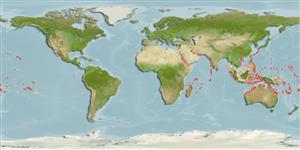>
Gobiiformes (Gobies) >
Gobiidae (Gobies) > Gobiinae
Etymology: Eviota: No etymology given, suggested by Christopher Scharpt: from Latin 'eu' for 'true' and 'iota' for anything very small, in combination 'truly very small' referring to it as being the smallest vertebrate at the time it has benn described by Jenkins (thus, making the suggestion by Scharpt plausible.
More on authors: Jordan & Seale.
Environment: milieu / climate zone / profondeur / distribution range
Écologie
marin récifal; profondeur 1 - 10 m (Ref. 90102). Tropical; 30°N - 25°S
Indo-Pacific:from the Red Sea, MaIdives and eastern Indonesia; north to Japan (Ryukyu and Ogasawara islands), through Micronesia to Line Is. across Polynesia (eastward to Pitcairns); south to Australia (west coast of Great Barrier Reef). New Caledonia, and across to the Tuamotus and Pitcairn Islands.
Taille / Poids / Âge
Maturité: Lm ? range ? - ? cm
Max length : 2.0 cm SL mâle / non sexé; (Ref. 1602)
Description synthétique
Clés d'identification | Morphologie | Morphométrie
Épines dorsales (Total) : 7; Rayons mous dorsaux (Total) : 7 - 9; Épines anales: 1; Rayons mous anaux: 7 - 8. Dorsal to anal fin-ray formula 8/8.
Body shape (shape guide): elongated; Cross section: compressed.
Inhabits inshore reefs in 1-10 m (Ref 90102).
Life cycle and mating behavior
Maturité | Reproduction | Frai | Œufs | Fécondité | Larves
Myers, R.F., 1991. Micronesian reef fishes. Second Ed. Coral Graphics, Barrigada, Guam. 298 p. (Ref. 1602)
Statut dans la liste rouge de l'IUCN (Ref. 130435: Version 2025-1)
Menace pour l'homme
Harmless
Utilisations par l'homme
Outils
Articles particuliers
Télécharger en XML
Sources Internet
Estimates based on models
Preferred temperature (Réf.
123201): 25.1 - 29.3, mean 28.4 °C (based on 2948 cells).
Phylogenetic diversity index (Réf.
82804): PD
50 = 0.5000 [Uniqueness, from 0.5 = low to 2.0 = high].
Bayesian length-weight: a=0.00794 (0.00404 - 0.01563), b=3.07 (2.91 - 3.23), in cm total length, based on LWR estimates for this species & Genus-body shape (Ref.
93245).
Niveau trophique (Réf.
69278): 3.0 ±0.3 se; based on size and trophs of closest relatives
Résilience (Réf.
120179): Haut, temps minimum de doublement de population inférieur à 15 mois (Preliminary K or Fecundity.).
Fishing Vulnerability (Ref.
59153): Low vulnerability (10 of 100).
🛈
Nutrients (Ref.
124155): Calcium = 531 [215, 1,876] mg/100g; Iron = 1.9 [0.7, 4.5] mg/100g; Protein = 17.6 [15.4, 19.5] %; Omega3 = 0.0962 [, ] g/100g; Selenium = 31.6 [7.8, 110.2] μg/100g; VitaminA = 105 [17, 608] μg/100g; Zinc = 5.42 [2.72, 9.52] mg/100g (wet weight);
